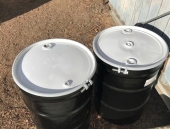This is my first build.
I rent single-wide house trailer (circa 1970, with 4” walls, unknown insulation, poorly constructed, 650 sq ft) that currently has no heat. Previous tenant used portable propane heaters. I am in Southern California in the hills above LA. It is noticeably cooler than living in the LA basin, but not as cool as the High Desert. It is about halfway in between the two, climate-wise. Heating Degree days is 2500.
I am going with a 6” RMH. I am using the Walker ceramic fiber core J design. I’ll wind up with something like Wisner’s 6” Annex design by the time I’m done. Just out & back with a flat bench. 2.5 ft x 9 ft, roughly. Drum & chimney completes an L shape to the straight bench at one end. I’m conscious of not putting too many turns in because my climate seems not cool enough to allow for great chimney draw.
I have a big pile of free red bricks to use and the local soil is very mineral rich, low clay, virtual no organic matter. I figure to just mix straight soil with fire clay for the cob, and call it done. Does that make sense? Is straw a necessary ingredient?
I am in the middle of reinforcing the suspended wood floor now to take the weight (easily done). It was 2x6 on 2 ft centers with 3/4” OSB and roll vinyl on top. Now it’s plenty hefty for the weight, but protecting the vinyl concerns me.
Plan A: Put greenboard, or masonry board, or something down on the vinyl. Put red bricks down flat on greenboard with plenty of air gaps (two-thirds air, one-third bricks, say). Put another layer of greenboard down. Build a rim of flat red bricks around the circumference. Fill the interior with perlite/clay, 2” (one brick depth) deep. Build up from there with cob.
Plan B: put greenboard down. Rim the circumference with vertical red bricks. Fill the interior with 4” of perlite/clay. Build cob up from there.
I’m not sure how important the air gap layer is for a wood/vinyl floor. Advice welcome.
Offhand, I prefer Plan B if the vinyl is safe that way ... less greenboard to purchase ... goes in faster ... and fewer spiders will move in under my RMH.
Thank you all for the forum and for being a cool community.



